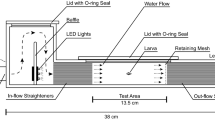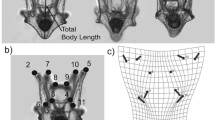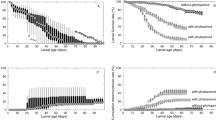Abstract
While developmental strategies can modulate the dispersal and recruitment of marine benthic species, the significance and drivers of propagule motility throughout ontogeny remain incompletely understood. Species with lecithotrophic (non-feeding) development are rarely studied, despite their predominance in some taxa, including echinoderms. Quantification of the swimming capacity (i.e. speed and trajectory) of early life history stages and its variability with environmental factors is required to improve the ability to predict population connectivity and assess trade-offs associated with complex life histories. In general, lecithotrophic larvae of echinoderms are ascribed weak swimming abilities relative to planktotrophic larvae, although explicit measures are scarce. Here, we explored selected metrics of swimming capacity in four co-occurring species of North Atlantic echinoderms displaying different types of pelagic development: planktotrophs represented by the sea star Asterias rubens and the sea urchin Strongylocentrotus droebachiensis, and lecithotrophs represented by the sea star Crossaster papposus and the sea cucumber Cucumaria frondosa. Swimming was characterized in still water based on the horizontal speed and path straightness of early life-history stages, from late blastula (hatched embryo) to late-stage larva. We tested the hypotheses that swimming capacity of propagules increases with progression through developmental stages and with increasing seawater temperature. Swimming speed increased with ontogeny in two of the four species (A. rubens and C. papposus) and with temperature in all species, although the effects of temperature were not uniform across life stages. The fastest swimming speeds across all species and temperatures were recorded in lecithotrophic propagules (i.e. max speed 1.2 mm s− 1 in the brachiolaria of C. papposus), whereas propagules of species with planktotrophic development displayed faster relative speeds (body lengths s− 1). Relative speeds increased with temperature in all tested species except C. papposus. Swimming paths typically increased in straightness from early to later developmental stages, and also became straighter with increased temperature in most species, except in C. papposus where they became more circular and complex. In general, planktotrophic and lecithotrophic propagules had similar swimming capacities when tested at the same level of increased temperature, though several stage-specific differences were detected; propagules of species with planktotrophic development had greater relative speeds at the gastrula stage and greater path-corrected speeds at the larval stage. Swimming paths and swimming speeds were similar between propagules of species with planktotrophic development and lecithotrophic development, suggesting that phylogenetically conserved, ontogenetic patterns of swimming capacity (seen here between two sea stars) may supersede the contribution of larval nutritional mode.



Similar content being viewed by others
References
Abelson A, Denny M (1997) Settlement of marine organisms in flow. Annu Rev Ecol Syst 28:317–339
Arshavsky YI, Orlovsky G, Panchin YV, Roberts A, Soffe S (1993) Neuronal control of swimming locomotion: analysis of the pteropod mollusc Clione and embryos of the amphibian Xenopus. Trends Neurosci 16:227–233
Barker M (1977) Observations on the settlement of the brachiolaria larvae of Stichaster australis (Verill) and Coscinasterias calamaria (Gray) (Echinodermata: Asteroidea) in the laboratory and on the shore. J Exp Mar Biol Ecol 30:95–108
Butman CA, Grassle JP, Buskey EJ (1988) Horizontal swimming and gravitational sinking of Capitella sp. I (Annelida: Polychaeta) larvae: implications for settlement. Ophelia 29:43–57
Byrne M, Barker M (1991) Embryogenesis and larval development of the asteroid Patiriella regularis viewed by light and scanning electron microscopy. Biol Bull 180:332–345
Byrne M, Soars N, Selvakumaraswamy P, Dworjanyn SA, Davis AR (2010) Sea urchin fertilization in a warm, acidified and high pCO 2 ocean across a range of sperm densities. Mar Environ Res 69:234–239
Chan KY (2012) Biomechanics of larval morphology affect swimming: insights from the sand dollars Dendraster excentricus. Int Comp Biol 52: 458–469. doi:10.1093/icb/ics092
Chan KYK, Grünbaum D, O’Donnell MJ (2011) Effects of ocean-acidification-induced morphological changes on larval swimming and feeding. J Exp Biol 214:3857–3867
Chan KYK, Jiang H, Padilla DK (2013) Swimming speed of larval snail does not correlate with size and ciliary beat frequency. PLoS One 8:e82764
Chenouard N, Smal I, De Chaumont F, Maška M, Sbalzarini IF, Gong Y, Cardinale J, Carthel C, Coraluppi S, Winter M (2014) Objective comparison of particle tracking methods. Nat Meth 11:281
Chia FS, Buckland J, Young CM (1984) Locomotion of marine invertebrate larvae—a review. Can J Zool 62:1205–1222
Childress S, Dudley R (2004) Transition from ciliary to flapping mode in a swimming mollusc: flapping flight as a bifurcation in Re. J Fluid Mech 498:257–288
Civelek CV, Daigle RM, Metaxas A (2013) Effects of temperature on larval swimming patterns regulate vertical distribution relative to thermoclines in Asterias rubens. J Exp Mar Biol Ecol 445:1–12. doi:10.1016/j.jembe.2013.03.010
Clay TW, Grunbaum D (2010) Morphology-flow interactions lead to stage-selective vertical transport of larval sand dollars in shear flow. J Exp Biol 213:1281–1292. doi:10.1242/jeb.037200
Clay TW, Grünbaum D (2011) Swimming performance as a constraint on larval morphology in plutei. Mar Ecol Prog Ser 423:185–196. doi:10.3354/meps08978
Collin R, Mobley AS, Lopez LB, Leys SP, Diaz MC, Thacker RW (2010) Phototactic responses of larvae from the marine sponges Neopetrosia proxima and Xestospongia bocatorensis (Haplosclerida: Petrosiidae). Invertebr Biol 129: 121–128 doi:10.1111/j.1744-7410.2010.00196.x
Daigle RM, Metaxas A (2012) Modeling of the larval response of green sea urchins to thermal stratification using a random walk approach. J Exp Mar Biol Ecol 438:14–23
Dorée M, Guerrier P, Leonard NJ (1976) Hormonal control of meiosis: specificity of the 1-methyladenine receptors in starfish oocytes. Proc Natl Acad Sci USA 73:1669–1673
Emlet RB (1983) Locomotion, drag and the rigid skelton of larval echinoderms. Biol Bull 164:433–445
Emlet RB (1994) Body form and patterns of ciliation in nonfeeding larvae of echinoderms—functional solutions to swimming in the plankton. Am Zool 34:570–585
Epp RW, Lewis WM (1984) Cost and speed of locomotion for rotifers. Oecologia 61:289–292. doi:10.1007/Bf00379624
Fenberg PB, Menge BA, Raimondi PT, Rivadeneira MM (2015) Biogeographic structure of the northeastern Pacific rocky intertidal: the role of upwelling and dispersal to drive patterns. Ecography 38:83–95
Gemmill JF (1914) The development and certain points in the adult structure of the starfish Asterias rubens. Phil Trans R Soc B 205: 213–294
Gemmill JF (1920) The development of the starfish Crossaster papposus. Q J Microsc Sci 64: 155–187
Gerritsen J, Strickler JR (1977) Encounter probabilities and community structure in zooplankton: a mathematical model. J Fish Res Board Can 34:73–82
Gross TF, Werner FE, Eckman JE (1992) Numerical modeling of larval settlement in turbulent bottom boundary layers. J Mar Res 50:611–642
Grunbaum D, Strathmann RR (2003) Form, performance, and trade-offs in swimming and stability of armed larvae. J Mar Res 61:659–691
Hamel J-F, Mercier A (1996) Early development, settlement, growth, and spatial distribution of the sea cucumber Cucumaria frondosa (Echinodermata: Holothuroidea). Can J Fish Aquat Sci 53:253–271
Harii S, Kayanne H, Takigawa H, Hayashibara T, Yamamoto M (2002) Larval survivorship, competency periods and settlement of two brooding corals, Heliopora coerulea and Pocillopora damicornis. Mar Biol 141:39–46
Holst S, Jarms G (2006) Substrate choice and settlement preferences of planula larvae of five Scyphozoa (Cnidaria) from German Bight, North Sea. Mar Biol 151:863–871. doi:10.1007/s00227-006-0530-y
Iyengar EV, Harvell CD (2001) Predator deterrence of early developmental stages of temperate lecithotrophic asteroids and holoturoids. J Exp Mar Biol Ecol 264:171–188
Jacobs DK, Nakanishi N, Yuan D, Camara A, Nichols SA, Hartenstein V (2007) Evolution of sensory structures in basal metazoa. Int Comp Biol 47:712–723 doi:10.1093/icb/icm094
Kashenko SD (2007) Adaptive responses of embryos and larvae of the heart-shaped sea urchin Echinocardium cordatum to temperature and salinity changes. Russ J Mar Biol 33:381–390. doi:10.1134/s1063074007060041
Kelman D, Emlet RB (1999) Swimming and buoyancy in ontogenetic stages of the cushion star Pteraster tesselatus (Echinodermata : Asteroidea) and their implications for distribution and movement. Biol Bull 197:309–314. doi:10.2307/1542784
Kingsford MJ, Leis JM, Shanks A, Lindeman KC, Morgan SG, Pineda J (2002) Sensory environments, larval abilities and local self-recruitment. Bull Mar Sci 70:309–340
Koehl M (2007) Mini review: hydrodynamics of larval settlement into fouling communities. Biofouling 23:357–368
Leys SP, Cronin TW, Degnan BM, Marshall JN (2002) Spectral sensitivity in a sponge larva. J Comp Physiol A 188:199–202. doi:10.1007/s00359-002-0293-y
Liu W, Pearce C, McKinley R, Forster I (2016) Nutritional value of selected species of microalgae for larvae and early post-set juveniles of the Pacific geoduck clam, Panopea generosa. Aquaculture 452:326–341
Loor A, Ortega D, Lodeiros C, Sonnenholzner S (2016) Early life cycle and effects of microalgal diets on larval development of the spiny rock-scallop, Spondylus limbatus (Sowerby II, 1847). Aquaculture 450:328–334
Maldonado M (2006) The ecology of the sponge larva. Can J Zool 84:175–194. doi:10.1139/z05-177
Marshall DJ, Keough MJ (2003) Variation in the dispersal potential of non-feeding invertebrate larvae: the desperate larva hypothesis and larval size. Mar Ecol Prog Ser 255:145–153
Marshall DJ, Krug PJ, Kupriyanova EK, Byrne M, Emlet RB (2012) The biogeography of marine invertebrate life histories. Annu Rev Ecol Syst 43:97–114. doi:10.1146/annurev-ecolsys-102710-145004
McDonald K (2004) Patterns in early embryonic motility: effects of size and environmental temperature on vertical velocities of sinking and swimming echinoid blastulae. Biol Bull 207:93–102
McDonald KA (2012) Earliest ciliary swimming effects vertical transport of planktonic embryos in turbulence and shear flow. J Exp Biol 215:141–151
McEuen FS, Chia FS (1991) Development and metamorphosis of two psolid sea cucumbers, Psolus chitonoides and Psolidium bullatum, with a review of reproductive patterns in the family Psolidae (Holothuroidea: Echinodermata). Mar Biol 109:267–279. doi:10.1007/BF01319395
Meidel SK, Yund PO (2001) Egg longevity and time-integrated fertilization in a temperate sea urchin (Strongylocentrotus droebachiensis). Biol Bull 201:84–94
Meidel SK, Scheibling RE, Metaxas A (1999) Relative importance of parental and larval nutrition on larval development and metamorphosis of the sea urchin Strongylocentrotus droebachiensis. J Exp Mar Biol Ecol 240:161–178
Mercier A, Hamel J-F (2010) Synchronized breeding events in sympatric marine invertebrates: role of behavior and fine temporal windows in maintaining reproductive isolation. Behav Ecol Sociobiol 64:1749–1765. doi:10.1007/s00265-010-0987-z
Mercier A, Doncaster EJ, Hamel J-F (2013a) Contrasting predation rates on planktotrophic and lecithotrophic propagules by marine benthic invertebrates. J Exp Mar Biol Ecol 449:100–110. doi:10.1016/j.jembe.2013.09.007
Mercier A, Sewell MA, Hamel J-F (2013b) Pelagic propagule duration and developmental mode: reassessment of a fading link. Glob Ecol Biogeogr 22:517–530. doi:10.1111/geb.12018
Metaxas A (2001) Behaviour in flow: perspectives on the distribution and dispersion of meroplanktonic larvae in the water column. Can J Fish Aquat Sci 58:86–98
Metaxas A, Saunders M (2009) Quantifying the “bio-” components in biophysical models of larval transport in marine benthic invertebrates: advances and pitfalls. Biol Bull 216:257–272
Mileikovsky SA (1973) Speed of active movement of pelagic larvae of marine bottom invertebrates and their ability to regulate their vertical position. Mar Biol 23:11–17
Mogami Y, Oobayashi C, Yamaguchi T, Ogiso Y, Baba SA (1988) Negative geotaxis in sea urchin larvae: a possible role of mechanoreception in the late stages of development. J Exp Biol 137:141–156
Moore SW (2003) Scrambled eggs: mechanical forces as ecological factors in early development. Evol Dev 5:61–66
Morgan SG (2014) Behaviorally mediated larval transport in upwelling systems. Adv Oceanog 2014:1–18
Mos B, Cowden KL, Nielsen SJ, Dworjanyn SA (2011) Do cues matter? Highly inductive settlement cues don’t ensure high post-settlement survival in sea urchin aquaculture. PLoS One 6:e28054
Myksvoll MS, Jung K-M, Albretsen J, Sundby S (2014) Modelling dispersal of eggs and quantifying connectivity among Norwegian coastal cod subpopulations. ICES J Mar Sci 71:957–969
North EW, Schlag Z, Hood R, Li M, Zhong L, Gross T, Kennedy VS (2008) Vertical swimming behavior influences the dispersal of simulated oyster larvae in a coupled particle-tracking and hydrodynamic model of Chesapeake Bay. Mar Ecol Prog Ser 359:99–115
Pawlik JR (1992) Chemical ecology of the settlement of benthic marine invertebrates. Oceanog Mar Biol 30:273–335
Pearce CM, Williams SW, Yuan F, Castell JD, Robinson S (2005) Effect of temperature on somatic growth and survivorship of early post-settled green sea urchins, Strongylocentrotus droebachiensis (Müller). Aquac Res 36:600–609
Pechenik JA (1999) On the advantages and disadvantages of larval stages in benthic marine invertebrate life cycles. Mar Ecol Prog Ser 177:269–297
Pizarro V, Thomason J (2008) How do swimming ability and behaviour affect the dispersal of coral larvae Proceedings of the 11th International Coral Reef Symposium, Fort Lauderdale, Florida, 7, pp 464–467
Podolsky RD, Emlet RB (1993) Separating the effects of temperature and viscosity on swimming and water movement by sand dollar larvae (Dendraster excentricus). J Exp Biol 176:207–222
Poulin E, Boletzky SV, Feral J-P (2001) Combined ecological factors permit classification of developmental patterns in benthic marine invertebrates: a discussion note. J Exp Mar Biol Ecol 257:109–115
Pringle JM, Byers JE, Pappalardo P, Wares JP, Marshall D (2014) Circulation constrains the evolution of larval development modes and life histories in the coastal ocean. Ecology 95:1022–1032
Puvanendran V, Brown JA (1998) Effect of light intensity on the foraging and growth of Atlantic cod larvae: interpopulation difference. Mar Ecol Prog Ser 167:207–214
Rebolledo AP, Emlet RB (2015) The parachute function of the hull in eggs of Mopalia kennerleyi (Chitonida: Mopaliidae), and swimming of its larvae through ontogeny. Invertebr Biol 134: 31–37
Reitzel AM, Miner BG, McEdward LR (2004) Relationships between spawning date and larval developmental time for benthic marine invertebrates: a modelling approach. Mar Ecol Prog Ser 280:13–23
Robins PE, Neill SP, Giménez L, Jenkins SR, Malham SK (2013) Physical and biological controls on larval dispersal and connectivity in a highly energetic shelf sea. Limnol Oceanogr 58:505–524
Roller RA, Stickle WB (1994) Effects of adult salinity acclimation on larval survival and early development of Strongylocentrotus droebachiensis and Strongylocentrotus pallidus (Echinodermata: Echinoidea). Can J Zool 72:1931–1939
Roy A, Metaxas A, Daigle RM (2012a) Changes in vertical distribution and aggregative behaviour in response to population density for larval sea urchins (Strongylocentrotus droebachiensis) and sea stars (Asterias rubens). Mar Ecol 33:194–204 doi:10.1111/j.1439-0485.2011.00480.x
Roy A, Metaxas A, Ross T (2012b) Swimming patterns of larval Strongylocentrotus droebachiensis in turbulence in the laboratory. Mar Ecol Prog Ser 453:117–127
Salama N, Collins C, Fraser J, Dunn J, Pert C, Murray A, Rabe B (2013) Development and assessment of a biophysical dispersal model for sea lice. J Fish Dis 36:323–337
Sameoto JA, Ross T, Metaxas A (2010) The effect of flow on larval vertical distribution of the sea urchin, Strongylocentrotus droebachiensis. J Exp Mar Biol Ecol 383:156–163. doi:10.1016/j.jembe.2009.11.014
Saranchova OL, Flyachinskya LP (2001) The influence of salinity on early ontogeny of the mussel Mytilus edulis and the starfish Asterias rubens from the White Sea. Russ J Mar Biol 27:87–93
Scheltema RS (1986) On dispersal and planktonic larvae of benthic invertebrates: an eclectic overview and summary of problems. Bull Mar Sci 39:290–322
Staver JM, Strathmann RR (2002) Evolution of fast development of planktonic embryos to early swimming. Biol Bull 203:58–69
Strathmann RR (1971) The feeding behaviour of planktotrophic echinoderm larvae: mechanisms, regulation, and rates of suspension feeding. J Exp Mar Biol Ecol 6:109–160
Strathmann RR (1993) Hypotheses on the origins of marine larvae. Annu Rev Ecol Syst 24:89–117
Strathmann RR, Grunbaum D (2006) Good eaters, poor swimmers: compromises in larval form. Int Comp Biol 46:312–322. doi:10.1093/icb/icj031
Strathmann RR, Grünbaum D (2006) Good eaters, poor swimmers: compromises in larval form. Int Comp Biol 46:312–322
Tamburri MN, Finelli CM, Wethey DS, Zimmer-Faust RK (1996) Chemical induction of larval settlement behavior in flow. Biol Bull 191:367–373
Thorson G (1949) Reproductive and larval ecology of marine bottom invertebrates. Biol Rev 25:1–45
Uthicke S, Schaffelke B, Byrne M (2009) A boom-bust phylum? Ecological and evolutionary consequences of density variations in echinoderms. Ecol Monogr 79:3–24
Villalobos FB, Tyler PA, Young CM (2006) Temperature and pressure tolerance of embryos and larvae of the Atlantic seastars Asterias rubens and Marthasterias glacialis (Echinodermata: Asteroidea): potential for deep-sea invasion. Mar Ecol Prog Ser 314:109–117
Visser AW, Kiørboe T (2006) Plankton motility patterns and encounter rates. Oecologia 148:538–546
Walker G (2004) Swimming speeds of the larval stages of the parasitic barnacle, Heterosaccus lunatus (Crustacea: Cirripedia: Rhizocephala). J Mar Biol Assoc UK 84:737–742
Walters LJ, Miron G, Bourget E (1999) Endoscopic observations of invertebrate larval substratum exploration and settlement. Mar Ecol Prog Ser 182:95–108
Webb CM (1989) Larval swimming and substrate selection in the brittle star O. brevispinum Reproduction, Genetics and Distributions of Marine Organisms: 23rd European Marine Biology Symposium. Olsen & Olsen, School of Biological Sciences, University of Wales, Swansea, pp 217
Wendt DE (2000) Energetics of larval swimming and metamorphosis in four species of Bugula (Bryozoa). Biol Bull 198:346–356
Wood S, Paris C, Ridgwell A, Hendy E (2014) Modelling dispersal and connectivity of broadcast spawning corals at the global scale. Glob Ecol Biogeogr 23:1–11
Wray GA, Kitazawa C, Miner B (2004) Culture of echinoderm larvae through metamorphosis. Methods Cell Biol 74:75–86
Young CM, Sewell MA, Tyler PA, Metaxas A (1997) Biogeographic and bathymetric ranges of Atlantic deep-sea echinoderms and ascidians: the role of larval dispersal. Biodivers Conserv 6:1507–1522. doi:10.1023/a:1018314403123
Acknowledgements
The authors wish to thank Memorial University Field Services for animal collections. The authors also wish to thank two anonymous reviewers and K. Gamperl (Memorial University) for constructive comments on the manuscript.
Author information
Authors and Affiliations
Corresponding author
Ethics declarations
All applicable international, national, and/or institutional guidelines for the care and use of animals were followed.
Funding
This work was completed with funding from Natural Sciences and Engineering Research Council Discovery Grant (#311,406) and Canadian Foundation for Innovation Grant (#11,231) issued to A. Mercier and an NSERC CGS-D Award to E. Montgomery.
Conflict of interest
The authors have no conflict of interest to declare.
Additional information
Responsible Editor: M. Byrne.
Reviewed by Undisclosed experts.
Electronic supplementary material
Below is the link to the electronic supplementary material.
Rights and permissions
About this article
Cite this article
Montgomery, E.M., Hamel, JF. & Mercier, A. Ontogenetic shifts in swimming capacity of echinoderm propagules: a comparison of species with planktotrophic and lecithotrophic larvae. Mar Biol 164, 43 (2017). https://doi.org/10.1007/s00227-017-3072-6
Received:
Accepted:
Published:
DOI: https://doi.org/10.1007/s00227-017-3072-6




